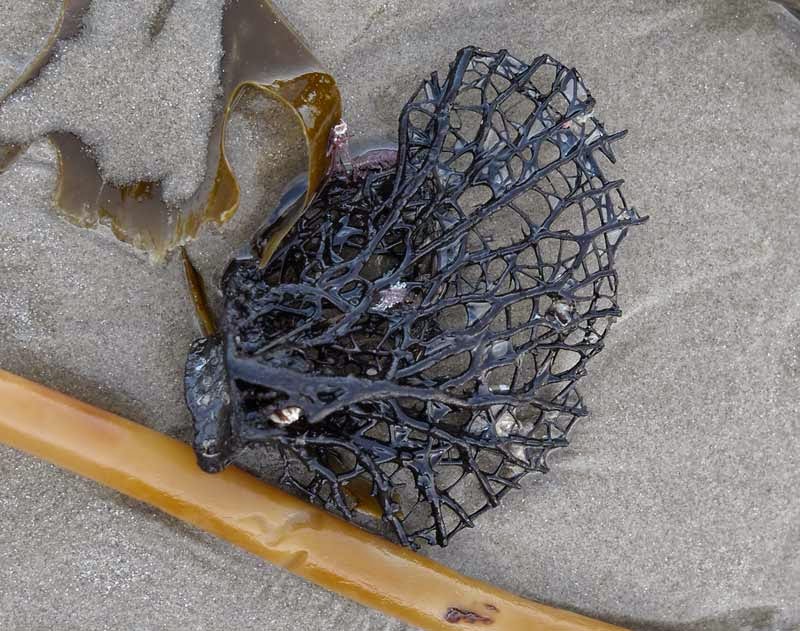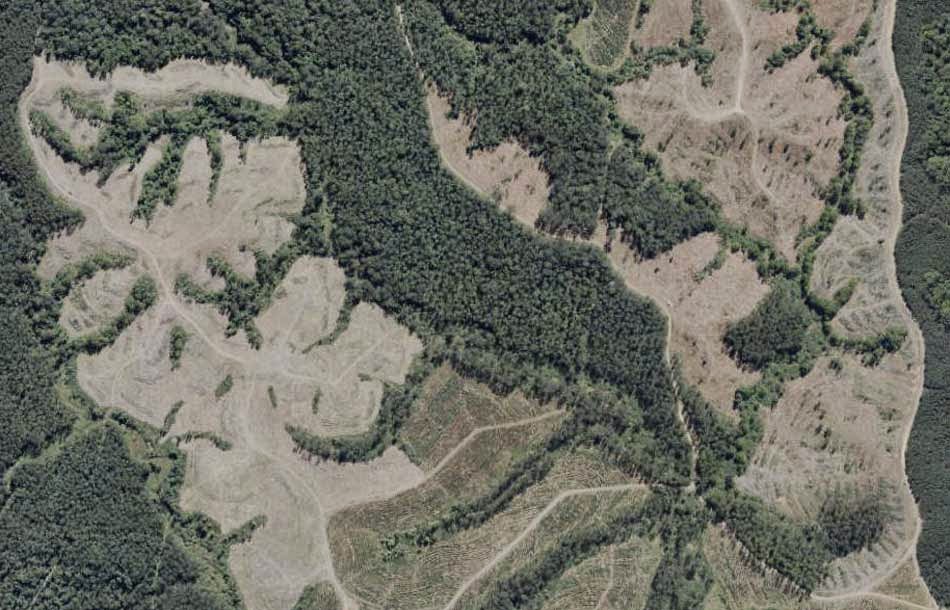Bellingen is a small logging town in
Gumbaynggirr Country. In the 1840s the Bellinger Valley was so "rich in
cedar that it was estimated that over 2 million feet of cedar were being extracted each year." (
source) By the early
1900s, the
red cedars were
depleted and cattle hit the cleared areas. By 1975, there were only
sclerophylls left to log. After the degradation of frontier
colonisation, other extractive industries besides
logging such as mining came on the scene. Pebbles from the Bellinger river and gold further 'opened' up the land. The ethos of '
dig it up, cut it down' permeates into the 21st Century where the whole country is truly '
open for business'.
Today
Bellingen is surrounded by an array of
state forests and national
parks. The state forests are intensively worked with heavy machinery,
agri-chemicals and fire. They are industrial forests.
Clear felling is widely practised. The national parks are seen
as a storehouse for the remaining biodiversity and a cash cow for 4W
Drive Tours for tourists. Even
car races are staged through some of the state
forests. Unregistered, uninsured and unlicensed
dirt bike riders harass bushwalkers and wildlife. Horse enthusiasts feel free to go anywhere. Other 'recreational activities' consist of
shooting and fishing.
Chasing the fairy-tale dream
Amongst
the remaining forest mosaic, more and more settlers try to live the
'Aussie dream' or are 'getting away from it all'. Retirees want a
tree change
with a lot of lawn. City dwellers are fatigued from house flipping and a
cut-throat work
culture and seek the stay-at-home lifestyle of the sleepy town. Old
hippies, retired
surfers, hipsters without contraceptives,
underachievers, young heirs, drop outs and oddballs all seek
some acres where the packs of
kids, dogs, horses or livestock can roam. 5 to 100 acre kingdoms promise a rootedness in land ownership for fringe dwellers.
Peri-urbanisation
or the quest for a cheap dwelling might also be a driving force for the
ever-growing community. Degraded land is converted into a real estate
Eldorado.
The conquered bush: fossil fuels,
pesticides and fire
Many
bring their sub-urban mental landscape with them. Everything is done in
the same way but only on a bigger scale. Sprawl and
automotive dependency require active denial about climate disruption. 'Land
management', private or by authorities or corporations, consists of two
'magic wands': fossil fuels and pesticide. If it can't be done with
heavy machinery, 2-stroke 'gardening' equipment (
pdf), slashers, mowers,
blowers and chainsaws and 'spray' - it won't be done. Beside petrol,
herbicide and
1080, fire is another tool to 'clean up the land' to make
it fit for human habitation. Private piles burn regularly and smouldering
forest fires burn over months, they are part of 'normal' culture. Seasonal
incineration of Australian flora and fauna, known as '
backburning'
turns the air into a
deadly smog.

Out here in 'the
middle of nowhere' one can 'break free', free themselves from all
restraint. Monster houses, monster SUVs, why have one dog, when one can
have 3 and a few cats. The dogs gang up and go for the remaining
wildlife. Bored fun-seeking teens organise 'out-of-control' parties in
the forests. 'Freedom' to be the one exempt form the law - to be wild. Yes, there is
no police station within an hour's drive.
The scenic
'little town' with an 'old world ambiance' has endless long quarry and
logging trucks with multiple trailers shooting through the 'sleepy
little town', down the Dorrigo mountains, along
Waterfall Way to
'upgrade' an XXL
Pacific
Highway which pushes all endemic bio-diversity
out of the way.
Tabula rasa for more of the same. Even when these 'trains' don't push
through the village road the daily vehicle
exhaust is
breath-taking. So
much for fresh country air.
The modern fairy tale is of endless growth on a finite planet.
Fossil-fuel reliance puts the world on track for
4-degree rise in
temperature. Most dwellings in the area have
coal-powered air-conditioning but not
solar. The refrigerated humans are OK so far, but the cattle in the 'great outdoors' are semi cooked, goats are
hammered by
hail and
even
roos and the
eucalyptus suffer. Bats drop out of the trees stone dead.
Turtles go blind and are starving. The disappearing endemic biodiversity
is invisible. This is a pet-loving country. But Australia appears free
of climate angst and goes: Great day for the beach! and drives the
meat gobbling
dogs to the beach to chase a few little terns or oyster catchers.
Back to the bush settlements -
The land-use conflict
Various
rural residential acres or hobby farms are scattered through the area.
Many borders are in proximity to a patchwork of industrial forests.
The presence of intense agro-chemical forestry, large scale fires and
residential areas can only generate conflict due to their potential
incompatibility. Both parties seek expansion, forestry and
roads and
increasing subdivisions of unplanned developments and residential
agglomerations. The conflict laden interface erupts when for example State Forests
wants to do aerial spraying via helicopters of a cocktail of pesticides
near dwellings. The majority of residents are already affected by the air
and noise pollution of
clear felling that lasts for months. Giant
machinery is ploughing up the ground from the early mornings. The subsequent
spraying of toxins and fires, as well as increased traffic take the charm out of
'country living'. The heavy logging machinery leaves behind
puddles of stagnant water that become
mosquito-infested (
pdf). Living in a spray and
logging zone with hovering helicopters and braking
trucks is more
reminiscent of the much
publicised Amazon basin, rather than a developed
country.
Most people seem to be teflon-coated and tolerate it all, many sell up and some
protest about the doings in their backyard.

Like
the original owners, residents feel disenfranchised about the invasion
of their properties.
Koalas and the rest of biodiversity do not get a
3 day notice about the toxic shower and the elimination of their
habitat. They are chased by packs of dogs and cars in a tree-less and fragmented
environment.
But a booming population is hungry for
building materials and infrastructure. The State Forest is already eyeing the
steep slopes of the native forests for
cable logging. Private loggers
might get the idea too. But a few more
landslides, erosion or flooding -
who cares.
The
dispersal of bio-cides on the land, water and
from the air is ubiquitous in Australia (
map). National parks, councils,
private individuals and agri-forestry almost all do it. The
'precautionary principle' is foreign lingo for humans or wildlife.

The latest case of land-use conflict came to a head between
residents near the Gladstone State Forest between
Bowraville and Bellingen. Forests NSW was going to aerial sprays herbicide over 175ha of logged
eucalyptus plantation. They argued that
"There is nothing unusual
about what we are proposing – farmers
all over Australia control weeds
using helicopters" (
source)
The spray would be a "combination of glyphosphate
(
RoundUp), Metsulfuron Methyl, Fluoroxypr Methy lheptyl, Simazine and
other chemicals from a helicopter" (
source)
The
Bellingen Green Action Group is concerned about the pesticide drift and the
impact on the many
waterways. Although aerial spray is so 'cost
effective'
SF will do ground spraying now.
The land use
conflict between human demands will continue. The interests and culture of big
quarry Australia will follow its logic till all is sold, unless the paradigm is changed.
Images:
Bellingen mural of settlers with axe
Bellingen downtown with logging truck
Bellingen logging images
Aerial sightseeing of some of the (random) forests bordering Bellingen town, all
Google maps
Update:
Now for the steep slopes west of Urunga and Nambucca Heads. Cable logging...
coffs coast advocate 15.03.2015
Stop Cable Logging on Steep Slopes in NSW Public Forests
Roundup weedkiller 'probably' causes cancer, says WHO study."The weedkiller has been detected in food, water and in the air after it has been sprayed, according to the report from WHO. However, glyphosate use is generally low in and near homes where the general public would face the greatest risk of exposure, the report said.
" The Guardian 22.03.2015
http://www.iarc.fr/en/media-centre/iarcnews/pdf/MonographVolume112.pdf
WHO, IARC Monographs Volume 112:
Evaluation of five organophosphate insecticides and herbicides 20.03.2015
http://www.stoptheaerialspray.org/
Improved protection from pesticides for NSW landowners, with new legislation passing Parliament
PDF via
@MarkSpeakman 14.05.2015
 |
| Culturing Ross River and Barmah Forest viruses? |




















































